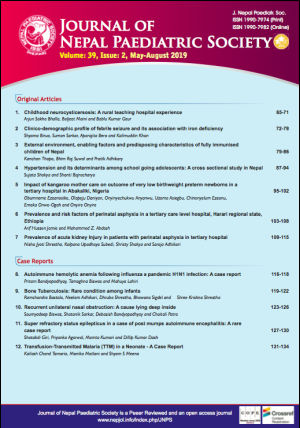External Environment, Enabling Factors and Predisposing Characteristics of Fully Immunised Children in Nepal
DOI:
https://doi.org/10.3126/jnps.v39i2.26287Keywords:
children, immunization, mothers, Nepal, Vaccine preventable diseaseAbstract
Introduction: Immunisation is a cost-effective public health intervention worldwide responsible for the reduction of infant and child morbidity and mortality. Full immunisation is a state of obtaining all vaccination according to the Immunisation schedule of Nepal.
Methods: The secondary data of Nepal was downloaded from the DHS Program. A total of 1709 children aged 16-23 months were analysed for descriptive statistics. All the analyses were weighted by its sampling weight. The full immunisation status indicates those who completed 1 dose of BCG, 3 doses of Polio, 3 doses of DPT and 1 dose of Measles. The independent variables are further subdivided into enabling, predisposing and external environmental factors.
Results: Over half of children (52.6%) were from Terai, nearly a quarter (23.0%) from province 2. More males (53.5%) and the majority of (86.1%) children with birth order one to three were immunised. Mother aged < 20 years (62%), working father (96.1%), working mother (59.7%), educated father (87.3%) and educated mother (70.7%) had children with complete immunisation. Non-smoker mother (94.6%) had fully immunised children. Nearly three quarters (73.5%) from a middle and rich family, those with PNC within 3 days (35.9%), delivered at a health facility (64.2%), and had PNC check from the skilled provider (12.1%) had completely immunised their children.
Conclusions: Significant differences based on external environment, enabling factors and predisposing factors for full immunisation status was observed. Specific interventions based on these factors are recommended.
Downloads
Downloads
Published
How to Cite
Issue
Section
License
Authors who publish with this journal agree to the following terms:
Authors retain copyright and grant the journal right of first publication with the work simultaneously licensed under a Creative Commons Attribution License that allows others to share the work with an acknowledgement of the work's authorship and initial publication in this journal.
Authors are able to enter into separate, additional contractual arrangements for the non-exclusive distribution of the journal's published version of the work (e.g., post it to an institutional repository or publish it in a book), with an acknowledgement of its initial publication in this journal.
Authors are permitted and encouraged to post their work online (e.g., in institutional repositories or on their website) prior to and during the submission process, as it can lead to productive exchanges, as well as earlier and greater citation of published work (See The Effect of Open Access).



